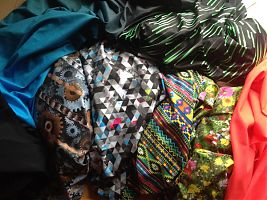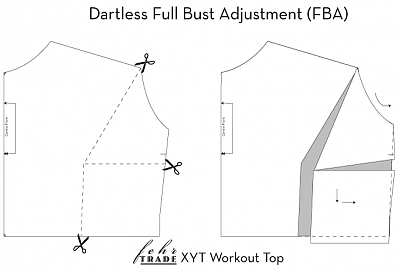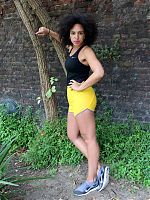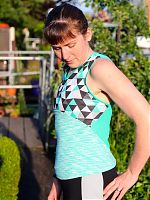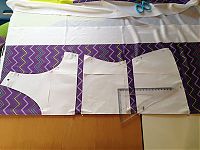Like anyone who’s had a site for a while (nearly 10 years, in my case!), I get an astounding amount of random email questions sent to me each day. Answering every single one of them takes up a considerable amount of my time, and sadly, I never get to reply to as many as I’d like. And frankly, sometimes I just get sick of telling people over and over that just because I posted about X magazine five years ago doesn’t mean I know where you can buy it! Or telling people that no, I don’t work for Burda/Patrones/Manequim/Lekala/whatever and I really can’t help you with your customer service issue.
For some reason, though, I received an unusually large amount of random questions while I was on holiday in NYC. I was moaning about it on Twitter, and Stacy suggested I compile them into an “Ask Melissa” column, which I thought was an excellent idea. I’ve spared you the truly random, boring ones, or the ones too specific to be applicable to anyone else, and instead just included a few here which others may be interested in.
Activewear Fabric Suppliers
I came across your website today and wanted to find out where you source the fabric for the sports clothes you make. Would you be able to tell me?
I’ve compiled a big ol’ list of suppliers (which I do my best to keep maintained!) over here!
Support for Large Busts
I’ve been admiring your work for several years now, having discovered you through your many rave reviews at patternreview.com. I’m not the best with knits, but I am about to try this summer, starting with your workout wear. I do CrossFit and high intensity classes, and am just giving up on finding clothes that will support my busty bust but fit my small rib cage. I am 32 DDD to G; can you recommend any of your patterns over the others for supporting large breasts? We spend a lot of time bouncing, upside down, etc. and form-fitting and supportive would be dreamy. And I see you even do bras; another reason I admire you!
With girls like that, you’re really going to need a very good sports bra underneath anything you’re wearing. I’ve got a good friend with 32I breasts and ShockAbsorber really seems to be THE brand for the well endowed. Grab a couple of those and wear them underneath your pretty, self-sewn exercise gear to get the best of both worlds, really! My XYT Workout Top has a built-in bra, but it’s really only going to be supportive enough for A-C cups, really, because it’s a compression-style bra, and larger breasts really need encapsulation-style, which is a MILLION times more difficult to sew on your own (and one I’m unlikely to produce a pattern for with all the engineering requirements involved!).
As for what to wear overtop of your supportive sports bra, well, in all of my top patterns I provide FBA instructions so you should choose a pattern size based on your High Bust measurement (while wearing your sports bra!), and then size up just the bust area accordingly. This should give you a much better fit in the body and bust, but of course, try this out in some cheap fabric first!
In terms of which is the easiest to do an FBA on, it’s probably my Surf to Summit Top pattern, as that has princess seams.
Exercise in hot & humid climates
Came across your write-up on Seam Work Mag about Activewear Fabrics. Very
insightful, by the way. I am in the process of starting a sportswear
apparel line in Africa, specifically in Nigeria.
I’m still trying to narrow down what the best fabric or combination of
fabrics would be best in this climate (hot, humid). Apart from the ones you
wrote about, are there any others you would recommend?
First of all, best of luck with your new sportswear line, that’s super exciting! Living in London, I only have the smallest personal experiences with running in hot weather (we might get a handful of days each summer where it’s over 30C/86F!), but from everything I’ve read, the main issue with exercising in hot and humid weather is directing sweat away from the body, and preventing chafing.
The first issue can be addressed through using wicking fabrics, like Supplex and aerated polyesters like DriFit, that move the moisture away from the body to the surface of the fabric where it can evaporate more easily. The chafing issue is mostly addressed through design – moving seamlines away from high-friction areas of the body wherever possible, and making these flatlocked (as flat as possible) when they can’t be moved.
Spoonflower activewear fabrics?
I’ve been a follower for quite some time and am a long time runner. Your story is quite inspirational. I recently purchased several of your patterns and am finally taking the plunge to make active wear. I found your post about where to buy work out fabric very helpful but have a follow up question. I am interested in spoonflower’s performance fabric and see that you enjoyed the pique more than the straight performance knit. My question is this: would you recommend the pique for just the tops for your patterns? And would the straight performance knit work for leggings?
Good question! The Spoonflower performance fabrics are fairly similar, but the Performance Knit has a smoother hand, and slightly less stretch, whereas the Performance Pique is more matte with a very subtle texture (far, far less than most piques!), and a bit more stretch, though in both, you get a bit of white show-through if it’s stretched nearly to the limit so you’ll want to try and avoid that.
The super, super important thing to remember, though is that BOTH Spoonflower performance fabrics only stretch in one direction – not two! Nearly all activewear patterns are drafted for two-way stretch fabrics (that is, fabrics that stretch both horizontally and vertically, not just horizontally). So if you make up my patterns straight off the pattern in a one-way stretch fabric, you’ll find that they feel a bit too short!
So you’ll need to add a little vertical length into my patterns, like I showed on my purple zigzag XYT Top.
In nearly all of my pattern instructions, I include adding length as one of the Common Fit Alterations, so it shouldn’t be too difficult to do, but I’d advise you make up the pattern in two-way stretch fabric a few times first to perfect the fit and get the hang of it before you graduate to using one-way stretch.
In terms of whether the Spoonflower fabrics will work for leggings, yes, with the caveats above! Myself and others have made shorts and leggings from them, and they’re a nice weight for tops or bottoms, in my opinion.
(And remember you can buy specially designed Spoonflower-printed fabrics for some of my patterns, too!)
——
So that’s it for now! I hope you enjoyed these answers, and, umm, please don’t send me any additional random email questions for the next column. Because seriously, I get enough already!!

